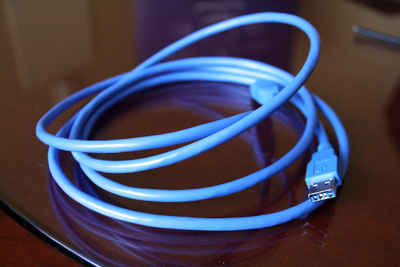A Quick Review on USB 3.0, Plus Cable Photos
No doubt you might not be familiar with the Universal Serial Bus (USB), but if you do that’s great to know – Its been ranked as a top PC innovation of all time by maximumpc.
Universal Serial Bus (USB) is a specification to establish communication between devices and a host controller (usually a personal computer), developed and invented by Ajay Bhatt, while working for Intel. USB has effectively replaced a variety of interfaces such as serial and parallel ports.
But what do you know about the next version of this ubiquitous interface? USB 2.0 (otherwise known as USB Hi-Speed) boosted USB 1.0 from 12Mbps data rate to 480Mbps over eight years ago, and now USB 3.0 (known as USB Superspeed) is set to multiply that bandwidth tenfold. Intel released the Extensible Host Controller Interface to hardware partners last week after some reported disputes with AMD and Nvidia (who, afraid Intel would have a jump start in incorporating the tech in chipsets, threatened to develop their own USB standard). But how does this affect you? We dug up some new information about USB 3.0 from www.maximumpc.com, they got their hands on the new connectors, and even took a look inside the new cables.
USB 3.0 will be backwards-compatible with USB 2.0
Like the upgrade from USB 1.0 to 2.0, the new 3.0 connectors and cables will be physically and functionally compatible with hardware from the older specs. Of course, you won’t be able to maximize your bandwidth unless you’re using a USB 3.0 cable with Superspeed devices and ports, but at least plugging a 3.0 cable into a 2.0 port won’t blow up your PC. The spec’s compatibility lies in the design of the new connectors. USB 2.0 cables worked off of four lines – a pair for in/out data transfer, one line for power, and the last for grounding. USB 3.0 adds five new lines (the cable is noticeably thicker), but the new contacts sit parallel to the old ones on a different plane, as opposed to being adjacent to them. This means you’ll be able to differentiate between 2.0 and 3.0 cables just by looking at the ends.
The maximum speed of USB 3.0 is 4.8Gbps
It’s true: USB 3.0 SuperSpeed will be 10 times faster than the 480Mbps limit of the 2.0 spec. The example Intel likes to give out when talking about the new speed is that transferring a 27GB HD movie to your future media player will only take 70 seconds with USB 3.0, while it would take 15 minutes or more with 2.0. Keep in mind that you’re only going to be able to take advantage of this speed if your portable storage device can write data that quickly. Solid state devices will benefit most from the speed boost, while magnetic hard disks will be limited by their RPM (
Revolutions per minute) and corresponding read/write speeds. Also, new Mass Storage Device drivers will have to be developed for Windows to take advantage of the specification.
USB 3.0 will charge more devices, quicker
Not only will USB 3.0 cables facilitate faster transfer speeds, but they’ll carry more power, too. The USB-IF recognizes the growing number of portable devices that charge via USB (cellphones, MP3 players, digital cameras), and have bumped the power output from about 100miliamps to 900 milliamps. That means not only will you be able to power more than 4 devices from a single hub, but the increase current will let you charge up heftier hardware as well.
Thanks to Maximumpc for this important piece of information…
Read more about this – http://j.mp/geC46T

